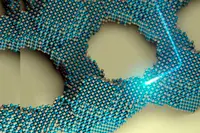 A research group from Cornell University in the US believes its work with quantum dot solids might help to usher in a new era in electronics.
A research group from Cornell University in the US believes its work with quantum dot solids might help to usher in a new era in electronics.
The team, led by associate professor Tobias Hanrath, has fused together lead-selenium nanocrystal building blocks to form atomically coherent square superlattices.
The difference between these and previous crystalline structures is the atomic coherence of each 5nm crystal. Because the crystals are connected to each other, their electrical properties are, potentially, superior to those of existing semiconductor nanocrystals. Potential applications are said to include energy absorption and light emission.
The strong coupling of the nanocrystals leads to formation of energy bands that can be manipulated, based on the crystals’ makeup, and could be the first step toward discovering and developing other artificial materials with controllable electronic structures.
In 2013, Hanrath’s group reported an approach to connecting quantum dots through the controlled displacement of a connector molecule. That paper said ‘connecting the dots’ was one of the hurdles to be overcome. But it notes that barrier seems to have been cleared with this new research.
Researcher Kevin Whitham said he sees the team’s work as a sort of challenge for other researchers. “This is as far as we know how to push it now,” he said. “But if someone were to come up with some technology, some chemistry, to provide another leap forward, this is challenging others to ask ‘how can we do this better?’.”
Hanrath said the discovery can be viewed in two ways. “It’s the equivalent of saying ‘now we’ve made a really large single crystal wafer of silicon and you can do good things with it’,” he said, referencing the early days of semiconductor technology. “That’s the good part. But the potentially bad part is … that if you wanted to improve on our results, those challenges are going to be really, really difficult.”
Pic: Kevin Whitham, Cornell University
Author
Graham Pitcher
Source: www.newelectronics.co.uk
